Alienware M11x R3: Portable Powerhouse
by Dustin Sklavos on July 22, 2011 1:15 AM ESTThe Fastest Ultraportable on the Block
Alienware's M11x R3 gets a big, big improvement with Sandy Bridge. Never mind the i7-2617M our review unit is equipped with, the minimum spec Intel Core i5-2537M has a higher nominal clock and faster turbo clock than the overclocked i7-640UM in the previous generation; it also has a slightly lower TDP and substantially improved performance clock-for-clock. Likewise, the NVIDIA GeForce GT 540M paired with it should bring equally notable improvements in performance--gaming and otherwise.


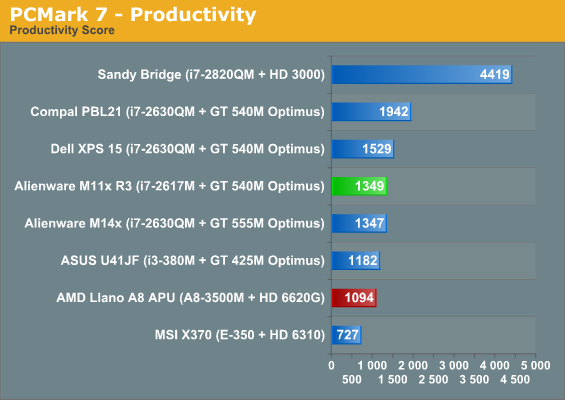
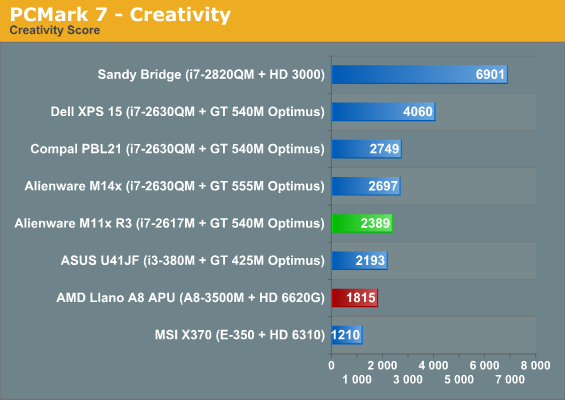
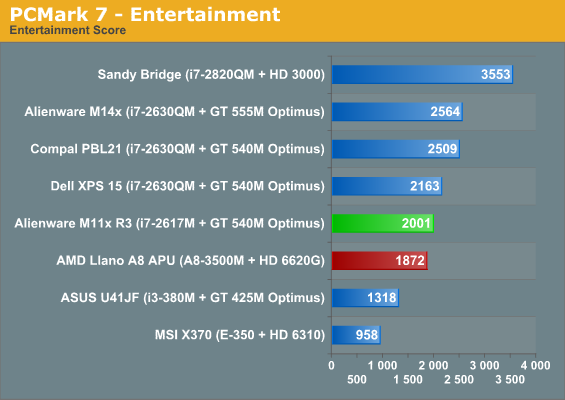
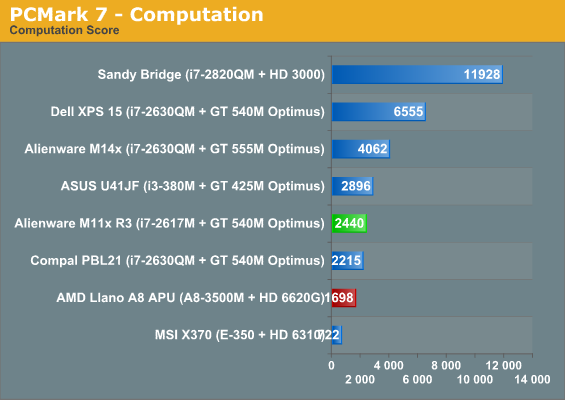
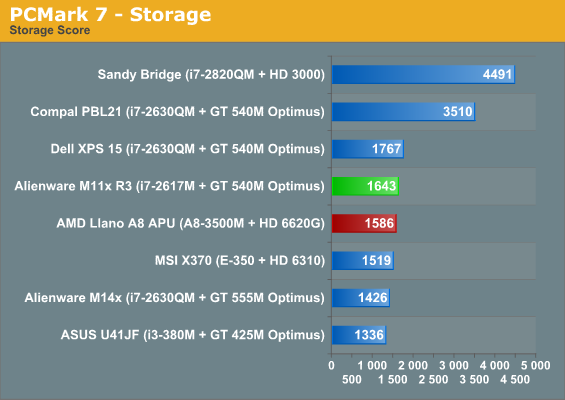
The M11x R3 may be packing a low voltage processor, but it certainly isn't slow. High turbo clocks and a fast GPU allow it to hang well with the rest of the pack and consistently beat out the old i3-380M, itself a faster CPU than the i7-640UM in the M11x R2. It's a shame we don't have PCMark 7 results from the earlier R2, but we do have results for other benchmarks, which we'll see below.

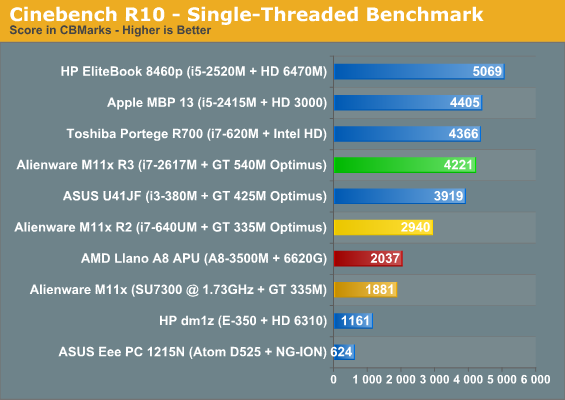
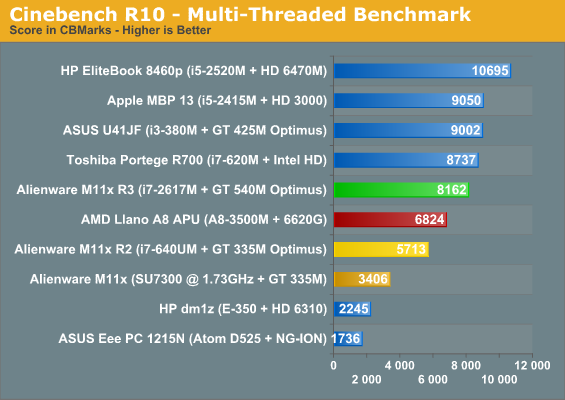
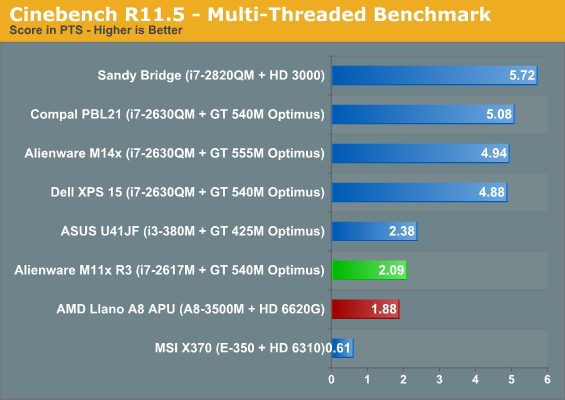
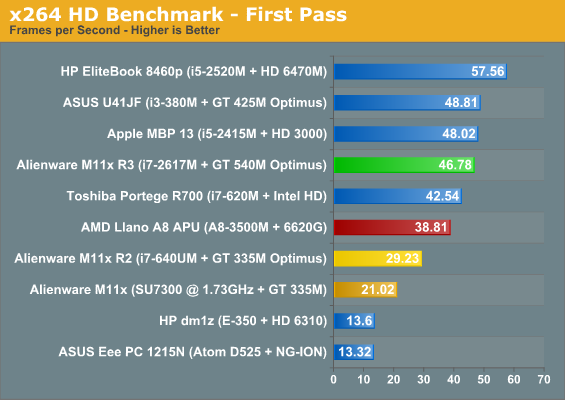
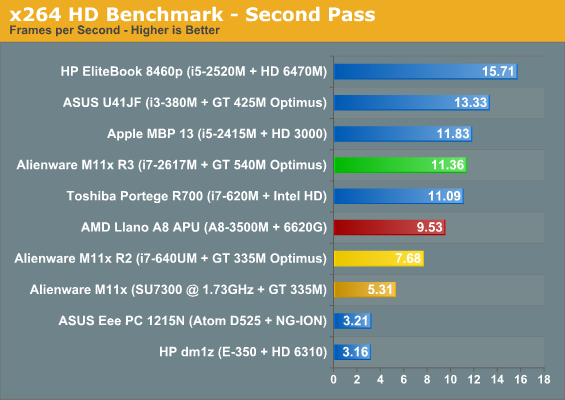
In every metric where the M11x R3 can be compared to its predecessors, it wallops them soundly. In fact it's consistently more than twice as fast as the overclocked Core 2 Duo SU7300 in the first generation unit, launched just 16 months ago! The U41JF posts unusually high scores, but it's worth pointing out that its i3-380M's nominal 2.53GHz clock speed has been ramped up by ASUS out of the factory to a robust 2.91GHz.
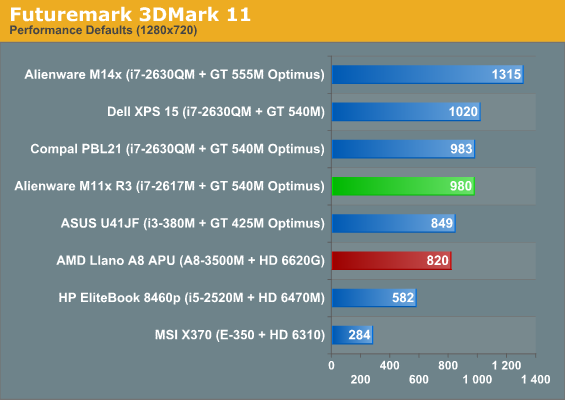
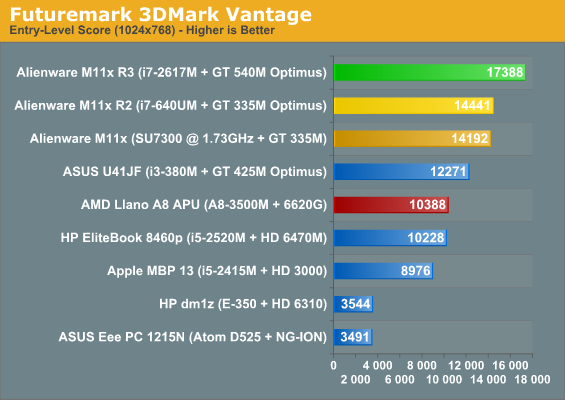
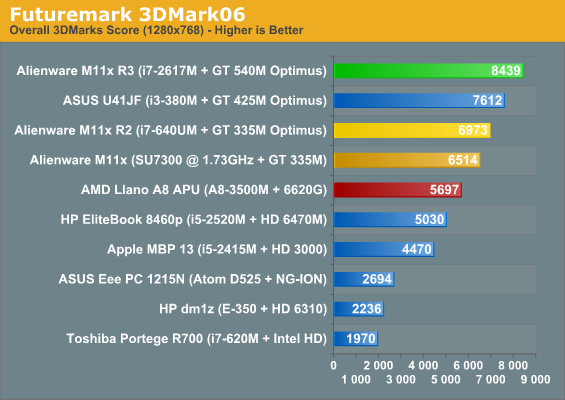
The Alienware M11x R3 proves absolutely monstrous in its weight class in 3DMark, and again demonstrates a substantial improvement in performance over the preceding models. With Sandy Bridge it definitely seems the M11x has finally gotten away from being heavily CPU-limited. The Dell XPS 15 sporting the same GPU but with a quad-core CPU only checks in a scant 4% faster in 3DMark 11, but let's see how that translates over to actual games.










55 Comments
View All Comments
ouchtastic - Friday, July 22, 2011 - link
forgot to say that 720p would work great too when output via hdmi, can game on any hdtv out there. Although I suspect nvidia settings might require you to play with overscan settings if you do this.Thermogenic - Friday, July 22, 2011 - link
I have an m11x R1 and generally like it, although the CPU really holds me back trying to watch MLB.tv.Can anyone comment on the webcam quality of the R3? I find the R1 to be exceptionally poor in low light situations, and not great even with good lighting.
rufwork - Friday, July 22, 2011 - link
"The R3 is easy to recommend over the R2. It's absolutely worth the money, definitely the best one Alienware's released thus far, and an easy sell for the portable gamer. The $999 stock configuration can easily be left unchanged..."CNET's running a deal now with the R2 (I believe) with i3 for $599.
Windows 7 Home Premium, 64Bit
Intel Core i3 330UM (3M Cache, 1.2 GHz) - Overclockable
11.6-inch WideHD 1366x768 (720p) WLED
1GB NVIDIA GeForce GT 335M
Alienware M11x a/b/g/n 2x2 MIMO Wireless
Is it really worth two-thirds the cost to move to R3 land? What games am I missing at R2 for $600 that I'm getting with R3 for a grand? Which doors can't I open? (Honest questions here; if the difference is a PS3, the answers should be pretty convincing ones, though, don't you think?)
redchar - Friday, July 22, 2011 - link
I wouldn't buy the stock for $1000. I've been waiting, and just recently the r3 has come out on dell's refurbished device website. I had seen the stock version for as low as $800, and the high-end i7 version for $900. Also, dell gives out coupons monthly to give discounts on the already discounted refurbished devices, usually between $100-200 off. So, before tax and shipping you might be able to get the stock version for $700 or something similar. Compared to the r2, you'd be getting better performance, usb3, and slightly better battery life. It might be worthwhile.Also, the refurbs get a 1 year warranty which covers free in-home repairs, so I really don't see a point in buying them new.
tzhu07 - Friday, July 22, 2011 - link
Does this company put any effort into industrial design? That thing looks like puke.dhiiir - Friday, July 22, 2011 - link
it doesn't look as ugly as I used to think. A small, mostly smooth black laptop if you think about it - a lot less uglier than some of the previous alienware designs with crazy ribs on the lid. It reminds me a bit of a ferrari, actually. You know - overall it will certainly stick out, but as long as you don't go out of your way to enable all the LEDs to make it look like a kids civic, the curves aren't too bad, or at least I can put up with them since the m11x has so many other great features.By the way, I would like to share a website with everyone, you can try clicking into perspective,-.www.upsfashion.com- there are many things we need, I often buy things here. Now share it with everyone. Can not miss it, or will be very unfortunate.dhiiir - Friday, July 22, 2011 - link
good ,i want to buy itmschira - Saturday, July 23, 2011 - link
my Lenovo t420s weights 3.94 pounds that is with a 14" screen. I wouldn't call it ultraportable thought....not that the t420s can compete in graphic power, unfortunately...
M
Luke2.0 - Saturday, July 23, 2011 - link
Forgive me if this sound noobish, or OOT.Taken from ark.intel.com for i7-2720QM
Memory Type: DDR3-1066/1333/1600
# of memory channels: 2
Max memory bandwidth: 25.6 GB/s
Could I put in a pair of DDR-1866 or 2000 modules and run them at said speed, thus more bandwidth?? 32 GB/s, anyone?
FYI I ask because I read Llano provides users with max 51.2 GB/s (some) thanks to the generous 128-bit bus, making me feel "why not,Intel?!"
You know, Ivy Bridge would get the same 25.6 GB/s of max bandwidth on paper, at least for now.
http://www.anandtech.com/show/4318/intel-roadmap-i...
Thanks.
erple2 - Saturday, July 23, 2011 - link
The answer is "yes, but it's only worthwhile where memory bandwidth is your limiting factor". Nowadays, I can't think of many situations where memory bandwidth (beyond a certain level, that is) has any significant play in the overall performance of the machine. Sure, if you're compiling large quantities of java code in parallel, or maybe certain tasks while manipulating large data files might be faster, I'm willing to bet that the additional cost of DDR1866 or 2000 memory modules would not translate into a reasonably measurable (> 5%) increase in performance. Unless there's no additional cost to fancier memory.Though that's more or less been the norm for the past 5 years - faster memory generally doesn't make a reasonable (considering it's price premium) choice. Note that overclocking can slightly justify better memory (faster, tighter timings, etc), but even there, the gains aren't necessarily in line with the resultant price premium.